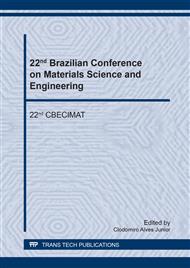p.14
p.20
p.26
p.32
p.37
p.43
p.48
p.53
p.57
Proppants Development and the Shale Oil and Gas Market Perspective
Abstract:
Unconventional shale gas reservoirs have driven the growth of the oil and gas market to a new reality: till 2035 a 26% increase in US fuel production is predicted. Thus, the hydraulic fracturing technique has been increasingly used as a resource for shale gas extraction and the consequent use of proppants. Several studies have now evaluated the use of nanostructures to produce special proppants, such as nanosensors, coatings, membranes and special fluids. This work presents the perspective of the market for oil, gas, shale, hydraulic fracturing and proppants in addition to a current development of proppants. Proppants were characterized through API RP 19C, DTA and DRX analysis. The morphology of carbon nanostructures (carbon nanotubes, carbon black and few layers’ graphite from reduced graphene oxide synthesis) produced and introduced on AM (alkali-activated metakaolin) matrix composites were evaluated using scanning transmission electron microscopy (STEM).
Info:
Periodical:
Pages:
37-42
Citation:
Online since:
September 2018
Keywords:
Price:
Сopyright:
© 2018 Trans Tech Publications Ltd. All Rights Reserved
Share:
Citation:


